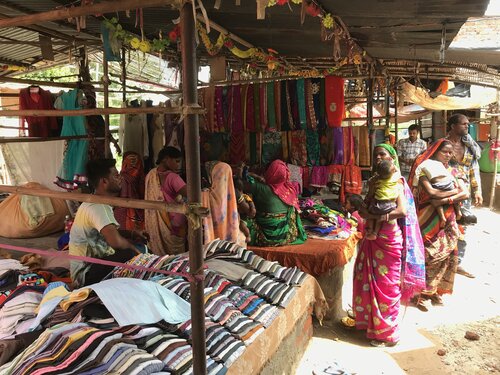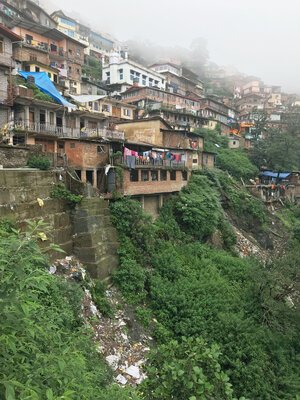COVID-19 may be an urban crisis, but India’s small cities will be its ‘collateral damage’
This post by Ayona Datta, Principal Investigator of the project Learning from Small Cities: Governing Imagined Futures and the Dynamics of Change in India’s Smart Urban Age. It has been reposted from the Learning from Small Cities website.
On 24th March, the Indian state announced a 21-day lockdown that would come in place within 4 hours. Almost immediately, thousands of migrant workers began to fall out onto the streets of cities like Delhi. The hawkers, the food vendors, construction workers, small-time businesses and a whole host of other connected economies collapsed within a few hours. Without any income, these migrant workers could no longer pay their rents. They could no longer sustain their meagre domesticities in the city whether as single migrant men or of their families back home. They needed to return, back to their native towns and villages. But they found that buses, trains and all other forms of public transport had been suspended. They began walking home, undertaking journeys that would take up to 15 days, without food or rest or money. Men and women carrying children, their few belongings, older children carrying younger siblings. These are images that will haunt the collective conscience of a nation for generations to come.
Small cities as ‘collateral damage’

There is no denying that COVID19 is an urban crisis in the way it has differential impacts on those in slums and informal settlements unable to quarantine or maintain social distancing. But second and third tier cities and towns in India are going to pay a higher cost for COVID19 than larger metropolises. Small cities have been unequal partners in India’s urbanisation with historically poor investment in infrastructure, planning and governance. Poor water supply, public sanitation, education and healthcare infrastructures combined with local governance deficits make them hotspots of infectious diseases. It is true that the numbers of those infected are low in smaller cities now, but this may be because of low testing levels in these cities. While bigger cities like Delhi, Bangalore and Mumbai are receiving much attention on COVID19 with resources redirected towards testing, ventilators and hospital beds, smaller towns and cities bursting with return migrants are finding it hard to cope with increased demands on their physical and social infrastructures. This virus is now a humanitarian crisis unfolding in India’s small towns and cities with no guarantees of food, livelihoods, healthcare or sustainable long-term futures.
Jalandhar, a second-tier city, was recently added to the list of India’s list of 100 smart cities. Under the recent COVID crisis, 45 Indian cities have transformed their Integrated Command and Control Centers (ICCC) into ‘COVID19 War Rooms’ where digital monitoring of quarantine measures, contact tracing, drone surveillance and mobile phone tracking have been put in place to control the virus.
In Jalandhar, the ICCC has not yet been constructed. But its inequalities go beyond the current lack of preparedness towards pathogenic carriers and therefore the impact of COVID19 will be unequally experienced by smaller cities like Jalandhar.
Jalandhar has been an emigration town which has seen internal out-migration and a sizeable NRIs (non-resident Indians) connection for a very long time. Facing years of under-investment, agrarian crisis and incursion of drugs, Jalandhar’s youth have looked for options elsewhere in India and abroad, making use of their translocal links with family and kin to find jobs and relocate. Jalandhar’s changing urban landscape has been to a very large extent attributed to the remittances from NRI income. Thousands of these internal migrants and NRIs have returned to Jalandhar in the last few weeks, some potentially carrying the virus but without effective quarantine measures in place. Jalandhar’s Civil Hospital has a 4 bed ICU and seven ventilators as preparation for COVID. If the numbers are higher, patients will have to be transported to larger hospitals in nearby Chandigarh. Punjab holds the fourth highest elderly population in the country (9.8% over 60) who are most vulnerable to the pathogen.
Under lockdown, Jalandhar’s clothing and sports industries are hardest hit. These are also industries that feed thousands of workers and their families. The city’s biggest second-hand clothes market is run almost exclusively by women migrants from Gujarat and Punjab. Their position there have always been under threat. These women traders have survived evictions, arrests and court orders but they now face an existential threat from a pathogen. Next to them another clothes market run mainly by Dalit shopkeepers have survived a devastating market fires and face continuing threats of eviction. These shopowners also employ migrant workers who would be returning to their home in the smaller cities and Deras in Punjab. On the outskirts of Jalandhar lies Qaji Mandi, a slum settled since 1940s by migrant families from South India. Their women are mainly food and vegetable sellers, men are labourers, sweepers or small-time shop owners. They have all lost their livelihoods in the lockdown.

Another hillside town – Shimla – was also added to India’s 100 Smart Cities programme but yet to build a fully functioning ICCC. It has a sizeable ageing population vulnerable to COVID19 infection, but it also has a relatively weak healthcare infrastructure. Circular migrants from across the Himachal region are returning home to Shimla, while coolies in Shimla are making their way back to their native land in Kashmir. As the paths of incoming and outgoing migrants cross along the Shimla tracts, it is almost certain that the virus is being transmitted and carried further along. It is also certain that the tourist economy in Shimla which only lasts a few months each summer is now devastated. This has put enormous stress on small businesses, their workers and an entire informal economy built around the tourist season. Shimla’s most vulnerable residents – its poor who are mainly lower caste Dalits live along the downward slopes of the hillside, in crowded houses that are literally cracking open as the land shifts and slides during monsoons each year. They have no other option but to wait it out through this crisis. Social distancing is a cruel irony here as families of upto 10 people are now confined in small overcrowded rooms. But there is a bigger existential crisis looming in the future. Without income or livelihood, they cannot carry out essential yearly repairs before the monsoon. They must hope that the virus will be gone before the monsoons wash away the hillside and their houses in a few months.
Pathogenic technologies
In the midst of these multiscalar crises, Indian cities have changed significantly. But it is not in their built form or layouts that we can (yet) see visible differences. It is in the virulent surveillance of pathogenic carriers through digital technologies where we see the most accelerated transformation of planning and governance.
A new normal of pathogenic technologies is now here with increased impunity. It legitimises itself by counting what can be measured – number of NRIs returning from abroad, numbers attending public gatherings, number of patients in hospital beds, numbers tested positive for COVID19. These feed into algorithmic predictions of infectious migrations. They also feed into measuring infections along caste and religious lines – whether the faithful gathering in Nizamuddin was more infectious than in Ayodhya, is fuelling media debates currently.
The impacts of COVID19 on small cities in India have been largely invisible so far. This is because impacts are based on what can be counted and measured – number of NRIs returning from abroad, number of patients in hospital beds, numbers tested positive. These feed into calculable predictions of future infections and economic slowdown. Migrant suffering on the other hand is unmeasurable and often invisible. Many do not have Aadhar cards, many do not know or cannot claim welfare benefits, most are not tested for the virus. Their lives are not bound by mathematical calculability. Their futures are determined by the availability of jobs, housing, food and a whole range of social and physical infrastructures. These complex relationships are harder to model. That they are returning to smaller cities and towns also makes these places invisible in the map of COVID19. The nature of our response to the invisible crisis in smaller cities will determine the course of India’s ‘urban’ future. This future lies not in the metropolitan cities, but in the rapidly urbanising regions. If we recognise that, we will know that this virus has made the crisis of urbanisation and migration visible like never before.